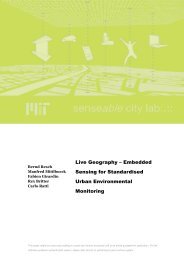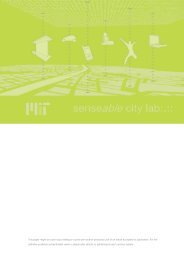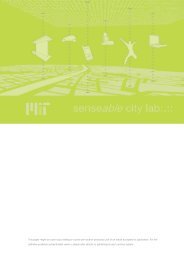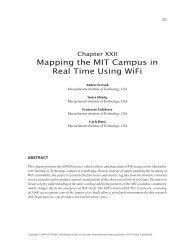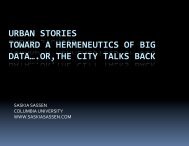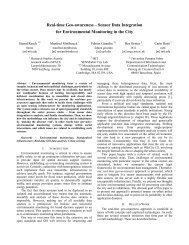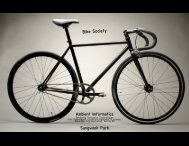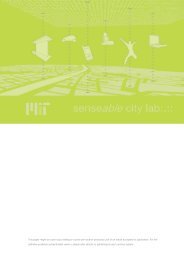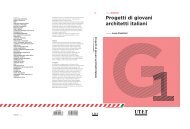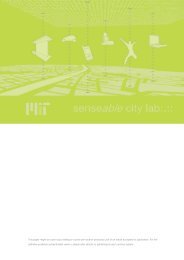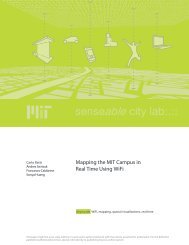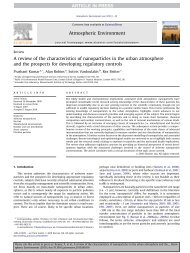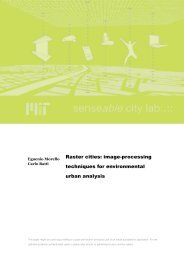Carlo Ratti - MIT SENSEable City Lab
Carlo Ratti - MIT SENSEable City Lab
Carlo Ratti - MIT SENSEable City Lab
You also want an ePaper? Increase the reach of your titles
YUMPU automatically turns print PDFs into web optimized ePapers that Google loves.
form, but also concerns structural aspects and relations between physical elements. However, we focus on<br />
providing a definition in terms of visibility for most of Lynch's elements, and show their calculation, thus<br />
providing a new quantitative way to describe and compare the spatial qualities of urban textures.<br />
2. The research context<br />
The first attempts to assess the environmental quality of urban spaces based on perception were presented<br />
in the late fifties and in the sixties as result of interdisciplinary studies in architecture, psychology, anthropology<br />
and sociology. The introduction of the discipline of proxemics by the American anthropologist Edward T. Hall<br />
(1960, 1966) opened up a series of applications in architectural and urban design. Proxemics is defined as the<br />
study of spatial interrelationships between people as they interact. Hall investigates the cultural aspects that<br />
involve human behavior in space. In his theory the ‘social field of vision’ determines human behavior and<br />
communication in social spaces. The key-descriptors for this discipline are the ‘social distances’ that enable<br />
different types of human activities and different levels of intimacy in the interrelationship between human beings.<br />
Many attempts to translate visual perception research into architectural and urban design theory followed.<br />
The best known contribution in urban planning studies is perhaps Kevin Lynch’s ‘The Image of the <strong>City</strong>’ (1960).<br />
This book deals with the look of cities and recognizes that giving visual form to cities is a design problem. “We<br />
are continuously engaged in the attempt to organize our surroundings, to structure and identify them. Various<br />
environments are more or less amenable to such treatment. When reshaping cities it should be possible to give<br />
them a form which facilitates these organizing efforts rather than frustrates them.” (p. 90). Everyone builds<br />
environmental images, helpful in the process of way-finding. These ‘city mental maps’ contain many elements<br />
that can describe our experience and the image of the environment; they can explain our tools for orientation and<br />
memorization, and represent an evaluation of the ‘legibility’ of a built context as well. ‘Legibility’ is the clarity of<br />
the cityscape, “the ease with which its parts can be recognized and can be organized into a coherent pattern”<br />
(1960, p. 2). As well as this concept, Lynch introduces the derived notion of ‘imageability’, which is “that quality<br />
in a physical object which gives it a high probability of evoking a strong image in any given observer. It is that<br />
shape, colour, or arrangement which facilitates the making of vividly identified, powerfully structured, highly<br />
useful mental images of the environment” (1960, p. 9). An important point in Lynch’s work is that he does not<br />
make a judgement on the value of different urban spaces, but he refers to ‘legibility’ and ‘imageability’ as<br />
2



